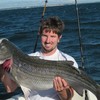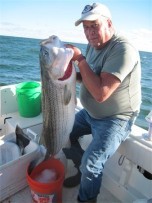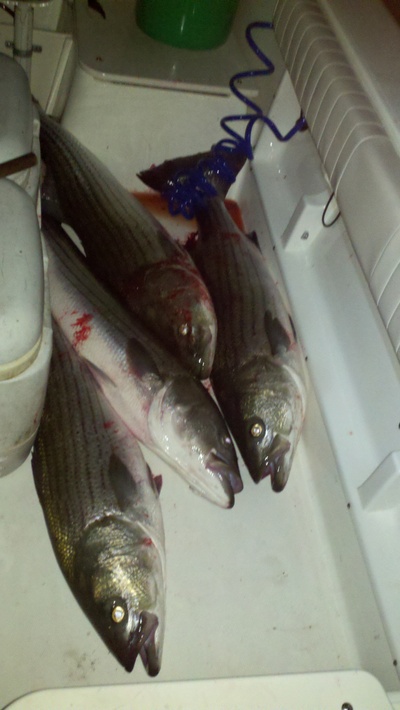Originally posted in the sports section of Barnstable Hyannis Patch. More pictures and a comment section can be found at:
http://barnstable-hyannis.patch.com/articles/understanding-big-bass-behavior
Finding big striped bass in Cape Cod Bay can be a downright overwhelming task. Then again there are those days when the bass just seem to find the fishermen.
One particular trip during the middle of August 2010 could certainly be classified as one of those rare occasions when big bass are easy to come by.
The wind was howling out of the southwest at around 20 knots. I had the Miss Loretta cruising east off the Sandy Neck shoreline when I noticed the first mark on the sonar. It was a nice fat orange blimp that could not be mistaken for anything other than a cow striper.
The tube and worm rigs quickly went into the water as I watched many more orange arches appear on the sonar screen. We were in business, and had found a considerably large school of stripers.
The cranking breeze was pushing the boat hard, and even with the engine in neutral our trolling speed remained above 4 knots. Traditional wisdom says tubes catch fish best if trolled at speeds less than 2 knots. However this trip would prove that tubes trolled at above average speeds can still produce impressive catches.
Bass after big bass came over the gunnels as we trolled in neutral, propelled by the breeze east towards Billingsgate Shoals. The wind had now increased to 25 knots, accelerating our troll and eastward drift.
The action finally died off a couple hours later, close to the SW tip of Billingsgate. We had trolled 6 miles directly east and had hooked up with at least one 15-40 pound bass every 10-15 minutes.
As I headed the bow west into the 3 foot chop, I wondered how we had managed to consistently hook up along the entire 6 mile trek.
Giant Schools of Bass or a Lucky Coincidence?
It is fun to imagine that we had encountered a 6 mile long school of keeper stripers-however I do not believe this was the case. The logical explanation is that we found a biomass of stripers that were moving eastward at the same rate as our 4-5 knot troll.
Had we been trolling slower, or in a different direction, it is reasonable to theorize that we may have lost track of the large school of bass much sooner. We were lucky that the speed and direction of our troll coincided nicely with the movement of the biomass of fish.
Stumbling upon a school of big bass in the Bay by complete chance does not occur often. We got lucky that day, however understanding the behavior of big striped bass played a major role in finding that biomass of fish in the first place.
Had we not already had an idea of a productive area and productive depth to begin our search, we would have missed out in a big way.
A Seasonal Influence on Large Striped Bass
Bass seem to behave differently depending upon the season. Having a general grasp of their seasonal patterns can help establish a starting point for a boat fishing in Cape Cod Bay.
During the spring, many bass are more apt to frequent areas closer to shore. This is good news for the shore bound and boat angler. When large schools of bass move in along the beach, it is easier to locate the fish and remain with the fish by using sonar, as described in "Developing a Strategy for Finding Big Fish."
Typically my springtime bass trips will begin around the mouths of creeks, in channels, and in waters with depths of 30 feet or less.
Once the middle of June rolls around, the vast majority of large bass abandon these shallow water haunts and retreat for the deeper water offshore. During the height of the summer, I will concentrate my efforts in 60-90 feet of water.
Of course there are exceptions, and on occasions we'll find bass much shallower than 60 feet. However, when establishing a starting point, it makes sense to at least begin my search at a depth with the greatest probability of holding fish.
As the summer wanes into fall, the majority of big stripers will once again begin congregating closer to shore. I remember multiple trips during the fall of 2010 when we found acres of bass ranging from 15-46 pounds in water as shallow as 7 feet.
It is a lot easier to stay on top of these shallow water bass, and it is possible to boat a lot of big fish in a considerably shorter amount of time than during the summer-when bass hold in the depths.
Big Bass Behavior during the Month of May
There are a lot of big fish to be caught right now. As I write this article there is a substantial amount of large fish being taken in the Cape Cod Canal. More than likely these fish will move north into Cape Cod Bay, followed by hundreds of thousands of more bass over the upcoming weeks.
Late May is prime-time for fishing the creeks and estuaries that empty into the Bay. A thorough sonar search of the beachfront area around the creeks may reveal some surprises.
When in shallow water (30 feet and less) color sonar units will sometimes display bass in the same fashion as weeds growing on the Bay's bottom. Being able to distinguish weeds from bass in these shallow areas is critical to success.
When in doubt, put the lines out.
Big Bass Potential for this Weekend
"Legendary" is how many fishermen described this past week's fishing at the Cape Cod Canal. Bentrods and big bass were seen up and down both sides of the land cut.Incrediblenumbers ofstripers assaulted adult pogies, mackerel, herring and whatever else they found swimming in theBig Ditch.
More than likely quite a few of these bassareexploring the creeks and beaches ofCape Cod Bay. Whether they plan on sticking around or continuing north is anyone's guess. Howeverthe staggeringamount of bass that passed through the canal just a few days agocertainly bodes well forfishermen heading out onto the Bay this weekend.




